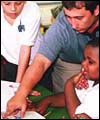| Suggestions for classroom activities |
 |
||||||
|
Vanesa
Escudero from Argentina asks:
|
| Roger replies: | ||
| Many of you will be starting to think about planning work for the new semester beginning in February, so this is perhaps a good week to try to answer this question. All of you will be using core materials of one type or another. Most of you will be using a coursebook. For many of you one of the key issues will be how to enliven these materials. | ||||
|
Here is one idea for activating vocabulary. Look through the units or chapters or materials that you will be drawing on during the coming semester. If you are teaching at pre-intermediate level in school, the topic range will typically extend from families and friends through homes and hobbies to holidays and travel. For any given unit, think how your students might be able to categorise or classify the core vocabulary relating to these topics. |
||||
|
Your classification chart might look something like this:
This is, of course, only an example. How you categorise the topics will depend on your own teaching circumstances: the nature of the materials to be studied; the abilities and backgrounds of your students; the cultural backdrop in your country. The classification activity is perhaps best used as a five- or ten- minute warmer as part of the introduction of the topic. The lexical items you decide to use will normally be selected from those arising in the listening or reading texts which link with this activity or you may decide to extend the list by selecting further items of interest or relevance.
|
||||||||||||||||||||||
|
Procedure Get your students to draw two or three columns (depending on the number of categories you have decided upon) on a piece of paper or in their exercise or vocabulary books. For the topic area in question, in this case 'summer clothes/winter clothes' dictate the words you have selected which will fit into one of the columns or categories. For an intermediate-level class, you may have selected: T-shirt, woollen scarf, fur-lined boots, sandals, shorts, hooded fleece, tank top, sun hat, denim jacket. The end result of the dictation should then look something like this: summer
clothes / winter clothes It may be useful then to carry out spelling and pronunciation / word stress checks by asking students to feed the items back to you. If you have each lexical item printed out on a piece of card, you can stick the cards under the appropriate columns. You can work on pronunciation/word stress as the students feed the items back to you and on correct spellings as you present or put up the cards. If you have included items, such as 'jeans' in this topic area, which might be categorised as either summer or winter wear, there will be opportunity for some class discussion as to where it best fits e.g. when in summer it is appropriate to wear them. If there are some new items arising, e.g. 'hooded fleece' which would benefit from visual support for final clarification, a picture of the item can be tacked on next to the word. |
||||
|
aAs a follow-up activity, the lists might be written out again by the students, perhaps working in teams, on A3 (or larger) size paper which could be put up on the walls. New items can then be added to the lists by members of the class as the investigation of the topic proceeds. Discussion of new items appearing on the lists might be cued by prompt questions such as: Teacher: "I see that somebody/Jos?has put 'thermal vest' under the 'winter clothes' column. Do you all know what a 'thermal vest' is? Where would you wear it? Why would you wear it? Is anybody wearing a thermal vest today?" This is just one idea, Vanesa, and hardly a new one, but I hope it is useful, can be applied at a variety of levels and that you can adapt it to your circumstances. |
||||